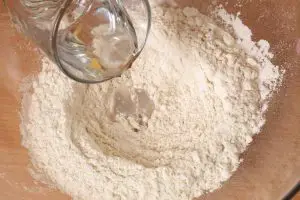Sourdough Rising Problems: A Detailed Guide
Bread that doesn’t rise is one of the most common problems for sourdough bread makers but do not dread.This guide is going to help you fix the problem.
Just the Basics
Instead of adding a store-bought yeast to sourdough bread, make a “starter” out of flour and water. Let it sit for a while, which results in the mixture making it’s own yeast. As you can imagine, the starter has to be just right in order to make bread that tastes delicious. You need to “feed” your starter on a daily basis, which essentially means removing some of it and then adding more water and flour to the mixture. Repeat it continuously until you are ready to bake your bread.
A lot of sourdough starter problems result from feeding your starter too infrequently, not letting it sit long enough to rise the proper amount, or adding too much flour to the starter once you start making your bread. When you follow the instructions for both the starter and the bread, you have to follow them to the letter; otherwise, the entire process can be ruined. But don’t let that scare you. The fact is that making sourdough bread takes some practice, and a lot of bakers simply don’t get it right the first time around.
What If My Bread Doesn’t Rise?
If your starter doesn’t rise, your bread likely won’t rise, either. And as far as the problem of sourdough bread not rising is concerned, it is usually due to one of the following reasons:
- Your starter isn’t able to raise itself. If it isn’t doubling in size between feedings, something isn’t right.
- You are baking it at the wrong time. Try to aim for those few hours in between when the dough has risen to a peak and when it starts to fall.
- The temperature is at the wrong setting. As a general rule, this means proofing your sourdough when it’s between 75 degrees and 82 degrees Fahrenheit.
- The dough’s temperature is wrong; aim for a dough temperature of around 78 degrees Fahrenheit.
- Remember that “wetter is better” when it comes to working with your dough. You can add some flour to make it easier to work with, but keep in mind that the dough for sourdough bread is always going to be a bit on the wet side.
- You are not kneading enough between rises. If your first rise is perfect and your second rise is less so, this could be the culprit.
- You are putting too much or too little dough in the pan before letting it rise. You should fill up the bread pan one-third to one-half of the way. Let the dough rise, then adjust the amount the next time.
- You are letting the dough dry out too much when it rises. If a thin “skin” develops over the dough and it feels a bit stiff, it’s time to place some plastic wrap over the pan or bowl as it’s rising. This is more important in some areas of the country than it is in others.
What to Do for Specific Problems
Just as with baking or cooking any other food products, there are solutions for problems related to the rising of the dough and others when you’re making sourdough bread. Since sourdough bread usually begins with a “starter,” both the starter and the baking of the bread must be done exactly as the instructions tell you to if you expect great results. If you’re new to making sourdough bread, it’s good to keep in mind the following tips:
- To determine if your starter is ready to be used, look for the following: a texture that is spongy and similar to marshmallows, a size that is doubled since rising, and bubbles on the top and throughout the starter mixture.
- Remember that when it’s colder outside, your dough may take longer to rise, since the temperature has a lot to do with how long it takes for your starter and dough to rise.
- If the weather is cold and you’re getting ready to start the dough, use warm water instead of cool water during the initial mixing phase so that it rises a lot quicker.
- Consider buying a proofing box, which is similar to a mini-greenhouse, in order to get the dough to the perfect temperature. They are usually expensive, but they are well worth it, especially if you intend to make sourdough bread on a regular basis.
Final Thoughts
Needless to say, when you’re troubleshooting sourdough bread, you’ll find a lot of advice and helpful suggestions on the Internet. The most important thing to remember is to follow the directions well, watch the temperatures as closely as possible, and, most of all, keep in mind that it may take you more than one loaf of bread to get it right.
That being said, you don’t have to be afraid of the bread-making process when you’re interested in sourdough bread. It’s just that some of the steps are a little different than making regular bread, so you’ll have to get used to those things before you perfect the process.






